A School Journey Into Eastern Cape’s Darkest Heart
Resource type: News
Daily Maverick | [ View Original Source (opens in new window) ]
By Mandy De Waal
While children in former Model C schools enjoy the privilege of excellent facilities, there are places of learning in rural areas without access to water, where pupils share grossly overcrowded classrooms, and where conditions essentially violate basic human rights. During a recent tour of these schools in the Eastern Cape, rights activists, academics and authors were completely shocked by what they saw.
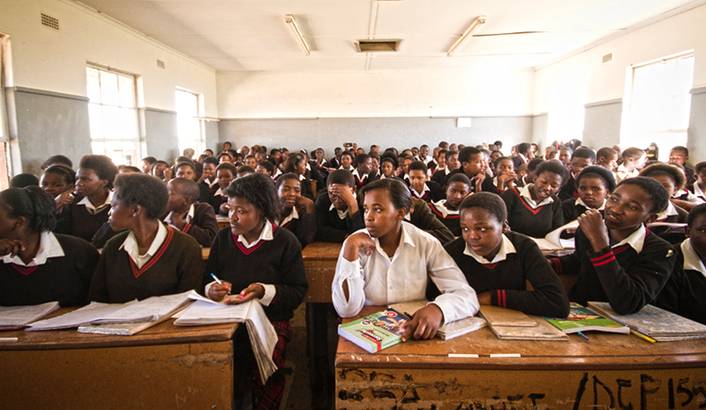
Photo: Over 130 learners packed into an overcrowded classroom at Ntapane Junior Secondary School.
Anger, sadness and disgust – those were just some of the emotions that flooded a group of luminaries who toured Eastern Cape schools with Anglican Archbishop Thabo Makgoba, and who witnessed first-hand facilities at a high school in Mthatha. The particular spectacle that caused the horror was the toilets. “Some in the group nearly fainted when they saw the sanitation at Ngangelizwe High School,” Elinor Sisulu, who was part of the tour, told Daily Maverick.
“This was a school with 876 students, and only four toilets that were overflowing and leaking. It was a serious health hazard and a real emergency situation,” said the author, human rights activist and political analyst. “The school said that they had written to the Department of Education two years ago, but had never received a response. One of the girls at the school said she had a problem… she would get pimples because of these toilets.”
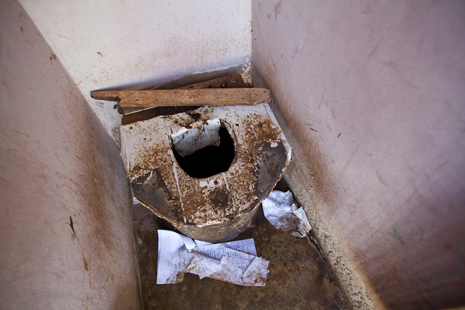
Photo: Shocking state of toilets at Nyangilizwe
Makgoba and Sisulu were joined on the tour by Janet Love, Sindiwe Magona, Njabulo Ndebele, Lindiwe Mokate, Zakes Mda, Graeme Bloch and Pierre de Vos. The solidarity visits were organised by activist movement Equal Education, and included education academics Nic Spaull (University of Stellenbosch) and Kim Porteus (Nelson Mandela Institute), as well as education lawyer Cameron McConnachie.
“These toilets are disgusting. No human being should use them, let alone a child,” author Mda said after visiting the Ngangelizwe High School toilet block. “It’s a very unhealthy situation. You can see even after using these toilets there is no place where they can wash their hands. It’s quite shocking. It’s something that makes me very angry.”
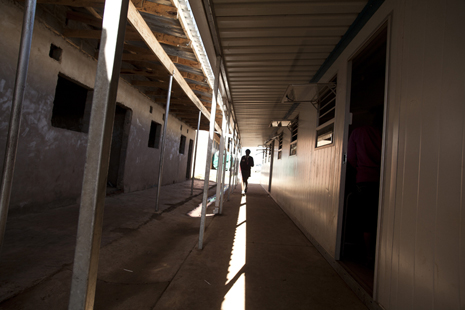
Photo: Prefab building stands next to incomplete classroom at Nyangilizwe
Equal Education’s General Secretary, Brad Brockman, told Daily Maverick that the delegates on the visit all have a history of social justice and human rights work, and that the lobbyists wanted the group to see and experience conditions in SA’s poorest schools – amenities that children and teachers must contend with every day.
“Sindiwe Magona broke down after seeing the toilets at Nyangilizwe Senior Secondary School in Mthatha, and hearing and seeing girl learners at the school expose the pimples on their skin they have as a result of using the broken pit latrine toilets smeared with faeces,” Brockman said.
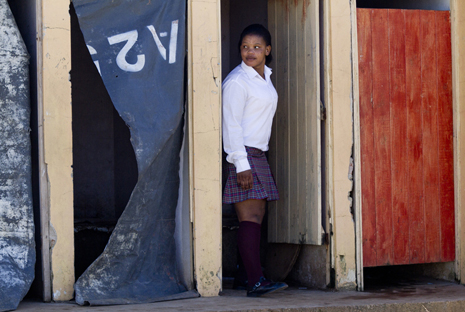
Photo: Learner uses toilets in terrible condition at Nyangilizwe Senior Secondary
“All of the delegates were deeply affected by what they saw,” he added. “Visiting Samson Senior Primary, a mud school in Libode, Zakes Mda asked why 50 years after he himself had attended school in the rural Eastern Cape, there were still children going to school under these conditions,” said Brockman.
Sisulu was struck by the lack of textbooks and reading materials in all the schools toured, while Bloch asked officials from the Department of Basic Education present during the visits why children were being taught in class to wash their hands after using the toilet, when there were no hand basins or soap in many of the schools visited.
Seeing SA’s school facilities crisis was a seminal experience for the people on the tour – who are now sharing their thoughts publicly during talks, on Twitter, on Facebook and other social media. The reach and the influence of this group means that a very public, global spotlight is being thrown on the local education crisis.
“It will take me long time to recover from the heart-wrenching experience of #SolidarityVisit. Until something is done I must not recover,” tweeted Mda, who flew out from the US, where he teaches creative writing at Ohio University. De Vos, the Claude Leon Foundation Chair in Constitutional Governance at the University of Cape Town, drew attention to the problem of overcrowding in one of his tweets: “#solidarityvisit At Ntapane Secondary School. Pic shows 135 learners in grade 9 class,” and in his Daily Maverick column.
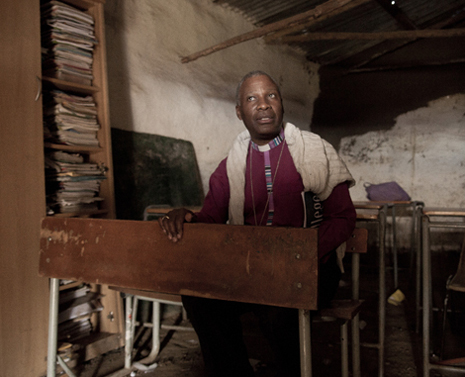
Photo: Archbishop Thabo Makgoba sits inside a mud classroom at Samson
The photograph shows a sea of faces crammed into what is a smallish classroom at the school situated in the Nyandeni municipality, in the area that used to be known as the Transkei. “The visits brought home the vast inequalities that exist in our education system solely based on infrastructure – the buildings and facilities, and how many children there are in a class,” said de Vos. “There is a huge discrepancy between the schools we went to in the rural Eastern Cape and what you will see in the former ‘Model C’ schools.”
Formerly schools that were reserved for white pupils during the Apartheid era, Model C institutions benefited significantly from hugely biased infrastructural spending before democracy. In her book The Right to Learn(written in the 80’s) the director of UCT’s School of Education, Pam Christie, detailed the disparity in education spending at that time. In 1982 the Apartheid government spent R146 (on average) educating a black child, but invested R1,211 on a white child.
The legacy of this is a government education system that has inherited two classes of schools. Beacons of privilege, Model C schools have good infrastructure where students (regardless of race) enjoy much better odds of passing matric, according to research. And then there are schools like those toured during Equal Education’s ‘solidarity visit’ that don’t even have perfunctory requirements that would make them compliant with basic human rights.
The Samson Senior Primary School in Libode, some 40km outside of Mthatha, currently doesn’t have any water tanks because these were destroyed by a storm: if a student needs water they have to walk about five kilometres to the nearest tap. Here children are taught in two mud huts. There used to be four mud huts, but two of them collapsed. The remaining huts are structurally unsound, bitterly cold in winter and unbearably hot in summer.
Equal Education organised the tour to draw attention to the conditions that learners and teachers must endure in rural schools in the Eastern Cape and across the country, and to highlight schools where SA’s prevailing schools infrastructure crisis is at its worst.
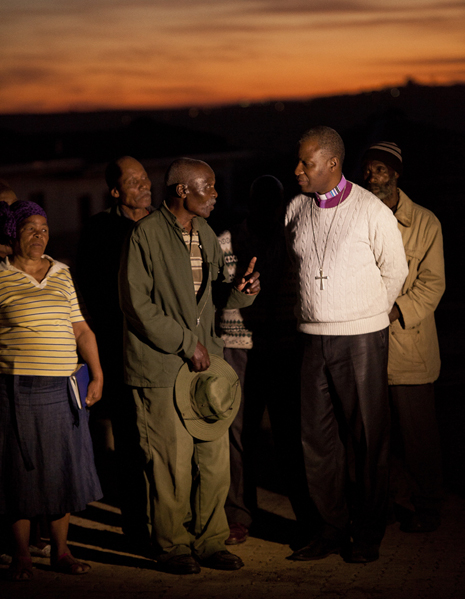
Photo: Archbishop Makgoba with community members at Nomandla Senior Secondary
The tour is a precursor to Wednesday 15 May 2013, a red-letter day when, in terms of an out-of-court settlement reached between Equal Education and DBE Minister Angie Motshekga, terms for the minimum norms and standards for school infrastructure need to be established. “These norms and standards will establish a legal benchmark for school infrastructure,” said Brockman.
“Provinces will have to ensure that all schools meet this benchmark, and communities will better be able to hold government accountable for providing school infrastructure. The visit is therefore part of our advocacy efforts to ensure that Minister Motshekga adopts clear, specific and comprehensive norms and standards, with reasonable time-frames for implementation,” Brockman explained.
The legal action is aimed at ensuring that schools like Ntapane Senior Secondary School, which is situated about ten kilometres outside of Mthatha, obtains desperately needed classrooms to reduce serious overcrowding. Here the group visited one classroom with 135 learners in it – a classroom that should only seat about 50. There are 836 learners in the school, which only has one tap and inadequate sanitation.
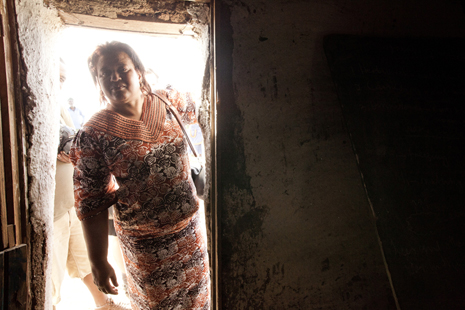
Photo: Elinor Sisulu at Samson Senior Primary School
“I walked into this class and found a lot of attentive young people who seemed engaged with their studies. They viewed us with a great deal of interest. In other words, I got the sense that the school children loved being there to learn,” writer and academic Njabulo Ndebele said of his experience of being at the school. “But I also couldn’t miss the fact that there was a great deal of overcrowding. In other words, the spaces between the desks – you can’t even go through. Contact between the teacher and the student, particularly those that are right in the back of the class, is almost impossible. The teacher can’t move around because the kids are bunched up together. The sense of overcrowding is palpable.”
As South Africa moves towards celebrating two decades of being a democracy, why is there such a discrepancy in schooling infrastructure, and why are some learners forced to attend schools with facilities that cannot cater to the even the most basic of human needs? “Obviously there’s a backlog that comes from before democracy,” De Vos said during an interview with Daily Maverick. “But many of the things that are the easiest to address – like infrastructure – have not been done or have not been done adequately. I would say that there are two reasons for this, the politicisation of education in the way union leaders play politics when they engage with departments; and linked to this is that there is a general lack of accountability in the whole system,” De Vos stated.
“There is no silver bullet or magic formula to fix this. If one had to start somewhere it would be with a sincere commitment from the highest political levels to provide at least basic, basic infrastructure befitting a human being, and with clear targets and deadlines and plans to make that happen,” De Vos said, and added: “Equal Education is trying to get the minister (Motshekga) to announce specific norms and target deadlines – but she has only announced a very vague and noncommittal programme that doesn’t set any clear targets or deadlines for doing what needs to be done.
“The second step is that there has to be a semblance of political will to bring accountability into the system, and to harness the energy of the parents who are often very much involved.”

Photo: Zakes Mda sits inside a mudschool, Samson Senior Secondary
Rights activist Sisulu said that government lacked a sense of urgency. “I didn’t get the impression that they didn’t care. It was more that they were overwhelmed,” Sisulu said of the education officials that accompanied the group during the tour. “The emergency of education facilities needs to be escalated nationally, and the basic norms and standards outlined by Pandor (when she was minister of education) should be resuscitated. Pandor’s draft related to norms and standards should rather be the accepted document because it is a much better and more comprehensive document (than Motshekga’s).”
To ensure that government stops failing children in these schools that don’t have the most basic of facilities to ensure access to a reasonable education, every citizen should stand with Equal Education and make sure Motshekga commits to specific norms and stipulated standards for all schools, according to an agreed schedule of delivery. It is that simple.
Read more:
-
Take a look inside Samson Senior Primary School in this Equal Education video on YouTube
-
Why do learners have to use toilets that look like this? at GroundUp
-
Eastern Cape’s forgotten schools in Mail & Guardian
-
Pupils demand better norms and standards for schools in Mail & Guardian
-
Angie’s draft school infrastructure norms flout Constitution in Mail & Guardian
-
Read more about Equal Education’s campaign for basic school infrastructure for every school
All photos by Sydelle Willow Smith.
Equal Education is an Atlantic grantee.